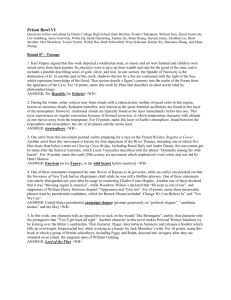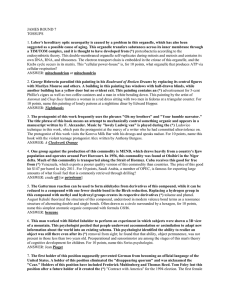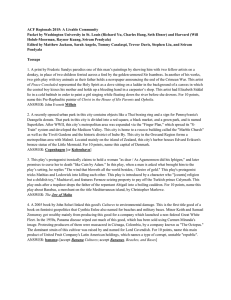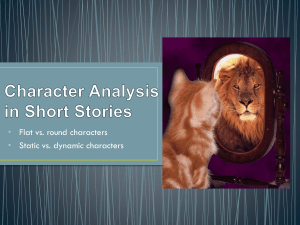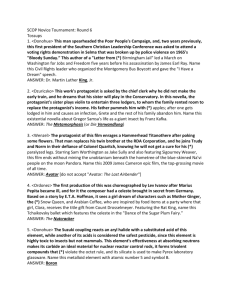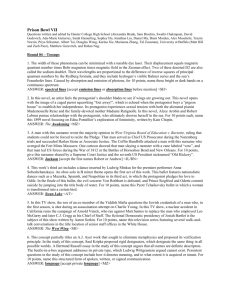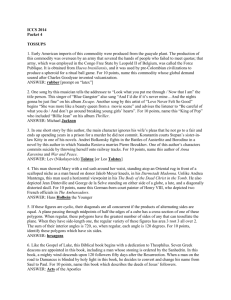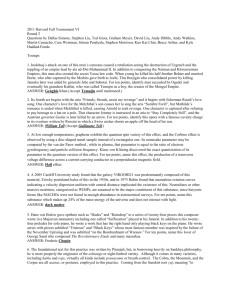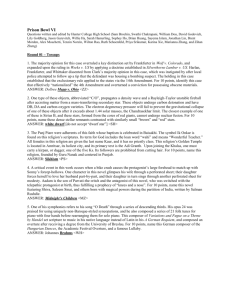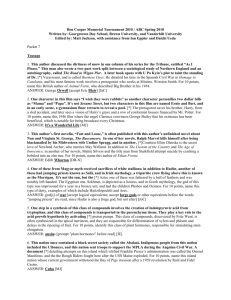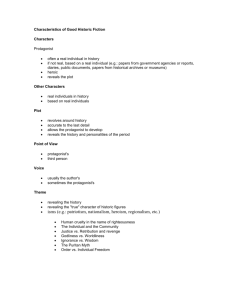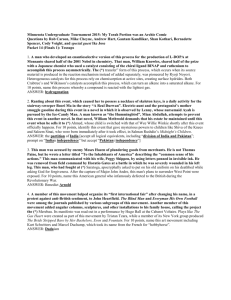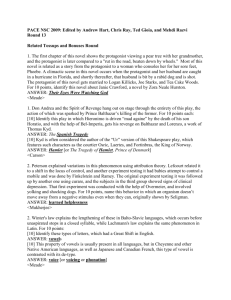Packet 5 REVISED - High School Quizbowl Packet Archive
advertisement
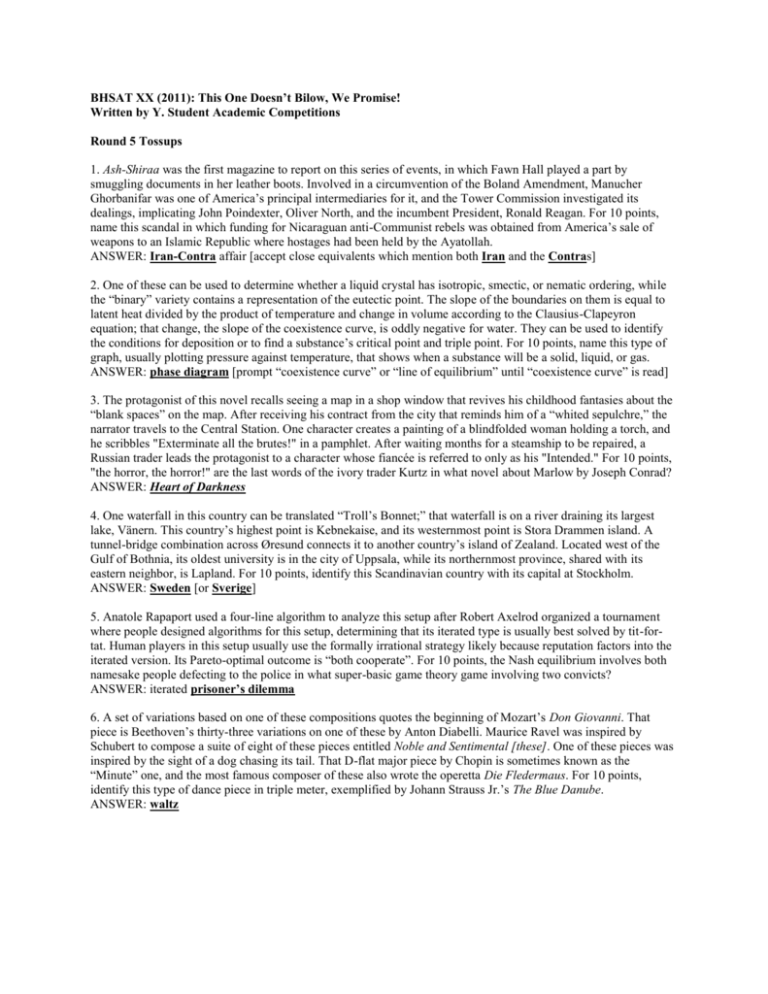
BHSAT XX (2011): This One Doesn’t Bilow, We Promise! Written by Y. Student Academic Competitions Round 5 Tossups 1. Ash-Shiraa was the first magazine to report on this series of events, in which Fawn Hall played a part by smuggling documents in her leather boots. Involved in a circumvention of the Boland Amendment, Manucher Ghorbanifar was one of America’s principal intermediaries for it, and the Tower Commission investigated its dealings, implicating John Poindexter, Oliver North, and the incumbent President, Ronald Reagan. For 10 points, name this scandal in which funding for Nicaraguan anti-Communist rebels was obtained from America’s sale of weapons to an Islamic Republic where hostages had been held by the Ayatollah. ANSWER: Iran-Contra affair [accept close equivalents which mention both Iran and the Contras] 2. One of these can be used to determine whether a liquid crystal has isotropic, smectic, or nematic ordering, while the “binary” variety contains a representation of the eutectic point. The slope of the boundaries on them is equal to latent heat divided by the product of temperature and change in volume according to the Clausius-Clapeyron equation; that change, the slope of the coexistence curve, is oddly negative for water. They can be used to identify the conditions for deposition or to find a substance’s critical point and triple point. For 10 points, name this type of graph, usually plotting pressure against temperature, that shows when a substance will be a solid, liquid, or gas. ANSWER: phase diagram [prompt “coexistence curve” or “line of equilibrium” until “coexistence curve” is read] 3. The protagonist of this novel recalls seeing a map in a shop window that revives his childhood fantasies about the “blank spaces” on the map. After receiving his contract from the city that reminds him of a “whited sepulchre,” the narrator travels to the Central Station. One character creates a painting of a blindfolded woman holding a torch, and he scribbles "Exterminate all the brutes!" in a pamphlet. After waiting months for a steamship to be repaired, a Russian trader leads the protagonist to a character whose fiancée is referred to only as his "Intended." For 10 points, "the horror, the horror!" are the last words of the ivory trader Kurtz in what novel about Marlow by Joseph Conrad? ANSWER: Heart of Darkness 4. One waterfall in this country can be translated “Troll’s Bonnet;” that waterfall is on a river draining its largest lake, Vänern. This country’s highest point is Kebnekaise, and its westernmost point is Stora Drammen island. A tunnel-bridge combination across Øresund connects it to another country’s island of Zealand. Located west of the Gulf of Bothnia, its oldest university is in the city of Uppsala, while its northernmost province, shared with its eastern neighbor, is Lapland. For 10 points, identify this Scandinavian country with its capital at Stockholm. ANSWER: Sweden [or Sverige] 5. Anatole Rapaport used a four-line algorithm to analyze this setup after Robert Axelrod organized a tournament where people designed algorithms for this setup, determining that its iterated type is usually best solved by tit-fortat. Human players in this setup usually use the formally irrational strategy likely because reputation factors into the iterated version. Its Pareto-optimal outcome is “both cooperate”. For 10 points, the Nash equilibrium involves both namesake people defecting to the police in what super-basic game theory game involving two convicts? ANSWER: iterated prisoner’s dilemma 6. A set of variations based on one of these compositions quotes the beginning of Mozart’s Don Giovanni. That piece is Beethoven’s thirty-three variations on one of these by Anton Diabelli. Maurice Ravel was inspired by Schubert to compose a suite of eight of these pieces entitled Noble and Sentimental [these]. One of these pieces was inspired by the sight of a dog chasing its tail. That D-flat major piece by Chopin is sometimes known as the “Minute” one, and the most famous composer of these also wrote the operetta Die Fledermaus. For 10 points, identify this type of dance piece in triple meter, exemplified by Johann Strauss Jr.’s The Blue Danube. ANSWER: waltz 7. One country in this conflict was ruled by its chancellor William Longchamp while its king participated; it was preceded by a crushing defeat at the Horns of Hattin, after which Guy de Lusignan and Raynald Chatillion were taken prisoner. Ending shortly after the Battle of Arsuf, at which one key player was Robert de Sablé, this campaign, called for by Gregory VIII and led in part by Phillip II Augustus of France, also included a Siege of Acre in 1190. For 10 points, name this conflict in which Richard Lionheart befriended his foe Saladin while failing to re-conquer Jerusalem. ANSWER: Third Crusade [accept Kings’ Crusade] 8. In this work, a misunderstanding causes one character to name her child "hello central". That child becomes ill, causing great anxiety for the protagonist's wife Sandy, and shortly afterwards occurs the bloody battle of the sandbelt. The protagonist is aided by Clarence, who helps him run his Man-Factory, which is used to educate peasants. The protagonist uses science to appear to work such miracles as restoring a dry fountain and causing an eclipse, which allow him to usurp the position of Merlin. For 10 points, name this work, which focuses on the time-traveling adventures of Hank Morgan, written by Mark Twain. ANSWER: A Connecticut Yankee in King Arthur's Court 9. The humorously named sonic hedgehog gene was first discovered in this organism’s embryos, in which the bicoid and hunchback genes facilitate its development from a syncytial blastoderm. The forelegs of its males have bristles, or ‘sex combs’. A mutation on the smallest of its four chromosomes eliminates its ommatidia, leaving it eyeless, and Thomas Hunt Morgan studied gene linkage using its white-eyed mutant form. For 10 points, identify this model organism in which one mutation switches legs with antennae, a winged insect. ANSWER: Drosophila melanogaster [accept fruit fly] 10. During his high school years at Simeon Career Academy, he was ranked “fifth best prospect” by Sports Illustrated, and he was named to the McDonald's All-American team. At college, he was coached by John Calipari where he helped lead his team to the final four, but missed a free throw at the end of the second half versus Kansas. After playing for Memphis, he was selected first in the NBA draft, and, while playing against the Boston Celtics, he tied a record for points scored by a rookie. However, he has recently been under investigation by the NCAA for academic dishonesty, invalidating Memphis’s 07-08 season. For 10 points, name this Chicago Bulls player who was accused of cheating on his SAT test. ANSWER: Derrick Martell Rose 11. A ragged beggar stands next to some oysters in this painter’s The Philosopher and the title figure sports a white bandana and black hat and strums a guitar in his The Spanish Singer. Théophile Gautier and Jacques Offenbach are among the luminaries standing in the title public garden in his Music in the Tuilieries. An African maid presents a bouquet to the title white nude female in another work, while a woman bathes in the background of his most famous work, in which two clothed men enjoy a picnic with a nude woman. For 10 points, name this French impressionist of Olympia and Luncheon on the Grass. ANSWER: Edouard Manet 12. A work of this name claims rules of conduct must exist alongside the “sentiment of justice” for justice to occur, two chapters after trying to find an “Ultimate Sanction”. Extended in Methods of Ethics by Henry Sidgwick and Animal Liberation by Peter Singer, this philosophy’s namesake book claims “better to be Socrates dissatisfied than a pig satisfied.” A type of consequentialism with “rule” and “act” forms, its founder proposed the Panopticon prison model and the “felicific calculus”. For 10 points, name this school of thought championed by John Stuart Mill and Jeremy Bentham, which believes moral goodness is the greatest happiness of the greatest number. ANSWER: utilitarianism 13. A 1966 film by Gillo Pontecorvo retold one campaign of this conflict. This conflict led to the Coup of 13 May, which in turn led to Operation Corse and Operation Resurrection. This conflict began on Bloody All-Saints Day. The Evian Accords resolved this conflict whose combatants included pied-noirs and the OAS; its end included a mass exodus after the Oran Massacre. Ahmed Ben Bella supported the FLN rebels in this conflict which occurred under Charles de Gaulle. For 10 points, name this conflict which resulted in the independence of a North African French colony directly to the west of Tunisia. ANSWER: Algerian War of Independence [accept Algerian Crisis] 14. Describing their motion was the original intent of a formula containing Pauli matrices, the Dirac equation. They are discharged en masse in a tube named for William Crookes; in an experiment using a nickel crystal, these particles were shown to diffract like waves by Davisson and Germer. Hertz discovered that they are emitted when matter is hit by sufficiently-energetic light. Emitted in beta-minus decay, they became the first discovered leptons in 1897, when J.J. Thomson determined cathode rays were made of them. For 10 points, name this ubiquitous elementary particle with negative charge. ANSWER: electrons [prompt “cathode rays” since it’s sort of unclear throughout] 15. In one scene in this play, a jester and a butler give alcohol to one of the main characters for the first time, and the three characters jointly agree to rebel against the tyrannical rule of the protagonist. While the protagonist easily foils this rebellion, the plot thickens when the son of the treacherous King of Naples, Ferdinand, falls in love with the protagonist's daughter, Miranda. For 10 points, name this play where the magician Prospero attempts to restore himself to his rightful position as Duke of Milan after conjuring up the title storm, a William Shakespeare romance. ANSWER: The Tempest 16. In one film by a director from this country, a photographer played by David Hemmings discovers while enlarging his photos that he has accidentally captured a murder being committed. Another director from this country showed Blondie and Tuco racing against Angel Eyes to find buried gold in a cemetery. Yet another director from this nation fictionalized himself as Guido Anselmi, haunted by the women in his life and having “director's block”. Those films are Blow-Up; The Good, the Bad, and the Ugly; and 8 ½. For 10 points, Michelangelo Antonioni, Sergio Leone, and Federico Fellini all hail from what country? ANSWER: Italy 17. When this deity intervenes in human affairs, he is sometimes known as Ygg, and he stumps the giant Vafthrudnir with a riddle. His possessions include a bracelet which replicates itself. He is often accompanied by Geri and Freki, or by Hugin and Munin, ravens who report to him, although when he sits on his chair, he can see everything, thanks to a deal he struck with Mimir. In order to obtain the wisdom of the runes, he hung himself on Yggdrasil, and he has only one eye. For 10 points, name this chief Norse god, who lends his name to the third day of the week. ANSWER: Odin (accept Wotan, or like, a billion other Norse kennings and associated anglicizations) 18. The anti-monetarist “wets” and rival “dries” were two types of people in the cabinet of this leader, who survived an assassination attempt from Patrick Magee’s bomb and advocated for the Community Charge, an unpopular uniform poll tax. A massive yearlong strike by the National Union of Mineworkers occurred during the tenure of this leader who, as Education Secretary, had earlier revoked schoolchildren’s free milk. Authorizing the capture of Stanley to win the Falklands War, and succeeded by John Major, for 10 points, identify this Conservative Prime Minister of Britain from 1979 to 1990, known as the “Iron Lady”. ANSWER: Margaret “Maggie” Hilda Thatcher, Baroness Thatcher [accept Edward Heath until “cabinet” is read] 19. The “fuzzball model” is thought to describe these objects, from which energy can be harvested by means of the Penrose process. Ones described by the Kerr metric cause frame-dragging within their ergospheres. Their only known properties are mass, charge, and angular momentum, due to the no-hair theorem. For a given mass, the Schwarzschild radius gives the surface of their event horizons, which contain a singularity of infinite density. Studied by Stephen Hawking, for 10 points, identify these massive, compact space objects from which not even light can escape. ANSWER: black holes 20. Characters named Card Player, Lead Actor, Young Man, and Young Girl are found in a play by one author from this country, The Other Shore. That author wrote of characters named Hothead and Old Man with Glasses waiting at the title Bus Stop and about characters named “I” and “you” attempting to reach the title locale in Soul Mountain. Another novel from this country opens with the release of the spirits of 108 outlaws. The protagonist of another novel from this country is accompanied on his travels by Friar Sand and Pigsy. For 10 points, name this country of origin of Gao Xinjian and of the classics The Water Margin and Journey to the West. ANSWER: China [or Zhongguo; accept The Other Shore or bi'àn until “one author from this country” is read] TB. One food item eaten during this holiday is named after the Greek word for dessert. At separate points during this holiday's central event, three and ten drops of wine are spilled. Ritual washings during that event are called Urchatz and Rach'tzah, and food items such as Maror, or bitter herbs, are consumed. The youngest children present traditionally sing a song known as Mah Nishtanah, which asks four questions about this holiday. The event on which this holiday is based involved the faithful marking their doors with lamb's blood; today, the main preparation for this holiday involves purging one's house of leavened bread. For 10 points, name this Jewish holiday which commemorates the Exodus from Egypt. ANSWER: Passover [accept Pesach; prompt on “Seder”] Round 5 Bonuses 1. Identify these American Civil War engagements, for 10 points each. [10] At this three-day July 1863 battle in Pennsylvania, Union Major-General Meade beat Robert E. Lee’s invading Confederates after Pickett’s charge failed. It was followed by a brief presidential address. ANSWER: Battle of Gettysburg [10] Ending on July 4 a day after Gettysburg, Ulysses Grant completed this siege in Mississippi, bringing that state’s namesake river under total Union control by destroying John Pemberton’s troops. ANSWER: Battle / Siege of Vicksburg [10] Including John Sedgwick’s claim that the enemy “couldn’t shoot an elephant” before being shot at Spotsylvania Courthouse, this May to June 1864 campaign into Virginia included the last Confederate victory, Cold Harbor. ANSWER: Ulysses Grant’s Overland Campaign [accept Wilderness Campaign] 2. Identify the following jazz vocalists, for 10 points each. [10] This “First Lady of Song” recorded eight “Songbook” albums dedicated to different American songwriters. She is perhaps best known for her virtuosic scat solos. ANSWER: Ella Fitzgerald [10] Nicknamed “Lady Day,” this singer co-wrote the songs “God Bless the Child” and “Lady Sings the Blues” and recorded an anti-lynching song written by Abel Meeropol, “Strange Fruit.” ANSWER: Billie Holiday [10] He began his career as a jazz pianist and singer, recording “Sweet Lorraine” in 1940, but he is best known for his more pop-oriented recordings like “The Christmas Song,” “Nature Boy,” and “Unforgettable.” ANSWER: Nat “King” Cole 3. Examples of them include the red and white forms of phosphorus. For 10 points each: [10] Give this term for the existence of multiple stable structural configurations of one element. ANSWER: allotropes [accept allotropy] [10] Graphite, diamond, and buckminsterfullerene are some of the allotropes of this element, which has more allotropes than any other. ANSWER: carbon [prompt “C”] [10] Carbon nanotubes and sheets of graphene are made of carbon arranged in an array of this geometric shape, which appears twenty times on the surface of a “buckyball”. ANSWER: regular hexagons [accept “arranged hexagonally” and equivalents] 4. Name the following schools of Chinese philosophy, for 10 points each. [10] Developed by Han Feizi and Li Si, this school advocated authoritarian rule and strict adherence to laws. It was adopted by the Qin dynasty, which banned competing schools by “burning the books and burying the scholars.” ANSWER: Legalism or Fajia [10] During the Han dynasty, this school of thought, which included Mencius and Xun Zi, debated the morality of human nature, and Zhu Xi started a new version of it during the Song dynasty. Its adherents believe in cultivating properties such as Ren and Li, and read the Analects of its founder. ANSWER: Confucianism or Rujia [10] This eponymous school, a Warring-States era rival to Confucianism, rejected ritual and propriety in favor of universal love, or jian ai. Its offshoots included the School of Names, and had ten triadic doctrines. ANSWER: Mohism or Mojia 5. Arvid Falk is the protagonist of his novel The Red Room, and he wrote a play in which the student Arkenholz is caught in the machinations of the satanic Hummel. For 10 points each: [10] Name this playwright of The Ghost Sonata who wrote about the struggle between Laura and The Captain over control of their daughter, Bertha, in The Father. ANSWER: August Strindberg [10] Strindberg hails from this country, also the home of Par Lagerkvist, author of The Dwarf and Barabbas. ANSWER: Kingdom of Sweden [or Sverige] [10] Strindberg’s most famous play is this one, in which the title character makes plans to run away with the servant Jean, but kills herself shortly after Jean kills her pet bird with a razor. ANSWER: Miss Julie 6. World War I ended with many land exchanges. For 10 points each: [10] At the Treaty of Versailles, France took back this territory along the border with Germany. Its capital is Strasbourg. ANSWER: Alsace-Lorraine [prompt on “Alsace” but not on “Lorraine”] [10] Romania acquired this western region from Hungary. Its eastern part includes Szekelyland. ANSWER: Transylvania [accept Erdely] [10] This northern town, the namesake of a nearby river of East Prussia, was stripped from Germany and later occupied by Lithuania. ANSWER: Memel [or Klaipeda] 7. Name some Biblical Prophets, for 10 points each. [10] According to Jews, the earthly arrival of this prophet in a chariot of fire will presage the coming of the Messiah. He criticized Ahab for leading the Baal-worship and marrying the foreign priestess Jezebel. ANSWER: Elijah [do not accept “Elisha”] [10] Elijah’s successor, this prophet won over the respect of the Israelites by parting the Jordan and ending a famine suffered by the people of Jericho. Over the years, he would help such Israelite kings as Jehoram and Jehu to restore the faith of the Israelites in God. ANSWER: Elisha [do not accept “Elijah”] [10] This so-called “weeping prophet” was treated kindly by Nebuchadnezzar, and allegedly wrote the book of Lamentations. ANSWER: Jeremiah 8. Even after going blind, he’d often work on problems in Saint Petersburg with one of his thirteen children at his knee. For 10 points each: [10] Name this super-prolific 18th century Swiss mathematician. His namesake number is approximately 2.718. ANSWER: Leonhard Euler (OIL-er; accept “yoo-ler”) [10] Euler's formula states that e raised to the i pi power is equal to this integer. It is a consequence of the fact that e to the i x is equal to the cosine of x plus i times the sine of x. ANSWER: -1 [or negative one or minus one] [10] Euler invented graph theory to resolve this problem, an attempt to find a closed path that traverses each of the namesake structures exactly one time. There is no solution. ANSWER: Seven Bridges of Königsberg problem [prompt partial answer; do not accept “Seven Bridges of Kaliningrad”] 9. It begins with the grandmother complaining that she would rather go to Tennessee than Florida, but she gets up early anyway and waits in the car in her Sunday best so that if she were to die in a car accident, everyone will know that she was "a lady." For 10 points each: [10] Name this short story in which the Misfit murders an entire family on vacation. ANSWER: A Good Man is Hard to Find [10] This Southern Gothic writer of A Good Man is Hard to Find wrote such other stories as "The Life You Save May Be Your Own" and "Everything That Rises Must Converge". ANSWER: Mary Flannery O'Connor [10] The Bible salesman Manly Pointer absconds with Joy Hopewell's prosthetic leg in this O'Connor short story. ANSWER: Good Country People 10. Name these anthropologists who studied island peoples, for 10 points each. [10] He studied the Inuit of Baffin Island but is more famous for his work on the potlatch system of the Kwakiutl and for teaching Ruth Benedict and Margaret Mead at Columbia. ANSWER: Franz Boas [10] This Polish-born anthropologist studied the Trobriand islanders in Coral Gardens and their Magic and Argonauts of the Western Pacific. ANSWER: Bronislaw Malinowski [10] He helped develop symbolic anthropology in his The Interpretation of Cultures, which contains his “Deep Play: Notes on the Balinese Cockfight.” He borrowed the term “thick description” from the philosopher Gilbert Ryle. ANSWER: Clifford Geertz 11. This ruler raised armies for conflicts including the War of the Devolution, dealt with the Fronde uprisings as a kid, and employed the finance minister Jean-Baptiste Colbert. For 10 points each: [10] Name this absolute monarch who ruled France from 1643 to 1715, known as the “Sun King”. ANSWER: Louis XIV [10] This Italian cardinal served as Louis XIV’s chief minister from that king’s accession at age 5 until 1661. ANSWER: Jules Mazarin [accept Giulio Raimondo Mazarino, or Mazarini] [10] Louis XIV invaded this region of another empire during the War of the Devolution. William the Silent’s United Provinces split from this region just before the Duke of Alba set up his Council of Blood here. ANSWER: the Spanish Netherlands [accept equivalent answers involving the ten provinces of the Low Countries administered by Spain; prompt “Flanders;” do not prompt “Belgium”] 12. Castor and Pollux, Apollo and Artemis, and Romulus and Remus are all examples. For 10 points each: [10] Name this sort of biological relation, which also includes Hunahpu and Xbalanque. ANSWER: twins [10] Xbalanque and Hunahpu are the Hero Twins who appear in this mythological work, in which they defeat Zipacna and travel down to Xibalba, where they play the sacred ball game with a human head. ANSWER: Popol Vuh [10] The Popol Vuh is a work of this Mesoamerican civilization whose other mythical figures include the rain god Chac and the bat god Camazotz. Their Kukulcan is cognate to Quetzalcoatl. ANSWER: Quiche Maya 13. It ends with a triumphant quotation of the song “Gaudeamus igitur.” For 10 points each: [10] Name this piece written after its composer was awarded an honorary degree from the University of Breslau and based on student drinking songs. ANSWER: Academic Festival Overture, op. 80 [10] This composer of the Academic Festival Overture also composed a Tragic Overture and four symphonies, the first of which is in C minor and sometimes referred to as “Beethoven’s Tenth.” ANSWER: Johannes Brahms [10] Brahms dedicated a piece of this type to his friend Joseph Joachim, who was the soloist at its premiere. Alban Berg composed one “to the memory of an angel,” and Elgar’s was first recorded by a teenaged Yehudi Menuhin. ANSWER: violin concerto 14. Answer some questions about a plant tissue, for 10 points each. [10] Made of tracheids and vessel cells, this tubular tissue transports water and some minerals through the plant. It may be contrasted with the similar nutrient-transporting phloem. ANSWER: xylem [10] The negative pressure generated by this process, which entails the evaporative loss of water through stomata, drives water up xylemic vessel elements. ANSWER: evapo-transpirational pull [accept equivalents containing “transpiration”] [10] Primary xylem emerges from the procambium, a type of this undifferentiated tissue whose “apical” variety divides and grows into new cells at the tips of the plant. ANSWER: meristem 15. They include the stories How the Camel Got His Hump and The Crab that Played with the Sea, For 10 points each: [10] Give this collection of children's short stories, intended to explain why certain animals and objects have particular properties. ANSWER: The Just So Stories for Little Children [10] The Just So Stories are by this author of "The Man Who Would Be King" and the poems "Gunga Din" and "If" ANSWER: Joseph Rudyard Kipling [10] Perhaps Kipling's best known work is this one, a collection of stories including Rikki-Tikki-Tavi and three stories about the man-cub Mowgli who is antagonized by the tiger, Shere-Khan. Answer: The Jungle Book 16. He seized power in a military coup in 1969, overthrowing King Idris. For 10 points each: [10] Name this Leader and Guide of the Revolution, who is currently battling a large scale pro-democracy revolution. ANSWER: Muammar Gaddafi [10] Opposition to Muammar Gaddafi is mostly centered around this eastern Libyan city, which is home to the National Transitional Council. ANSWER: Benghazi [10] In preparation for a UN mandated no-fly zone, the United States and the United Kingdom launched over 120 of these in order to take out Libyan air defenses. They are named after a certain Native American tool. ANSWER: Tomahawk Cruise Missile or Tomahawk Missile or Tomahawk Land Attack Missile 17. Leaders of the “neo” incarnation of this empire included founder Tiglath-Pileser III, Sennacherib, and a noted library-owner, Ashurbanipal. For 10 points each: [10] Name this ancient empire of the Fertile Crescent, with capital at Nineveh. ANSWER: neo-Assyrian Empire [accept Ashur] [10] Assyria subjugated this city until Nabopolassar and his son Nebuchadnezzar II regained control in 612 BC. Its architecture included the blue-tiled Ishtar Gate, and its earlier rulers included Hammurabi. ANSWER: Babylon [prompt “Babylonia”] [10] The namesake of a later Nestorian ritual, Nebuchadnezzar’s neo-Babylonian dynasty was also known by this name. Its last member was Nabonidus, who lost the empire to Cyrus the Great. ANSWER: Chaldeans [or Chaldees or Kasdim; accept 11th dynasty of Babylon[ia]] 18. Identify some German painters, for 10 points each. [10] He painted portraits of Thomas More and Erasmus and a double portrait with a hidden anamorphic skull, The Ambassadors. ANSWER: Hans Holbein the Younger [10] He depicted very many Christians being slaughtered in his The Martyrdom of the Ten Thousand. A despondentlooking angel holding a compass sits next to a sleeping dog in his Melancolia I. ANSWER: Albrecht Dürer [10] This contemporary of Durer’s included scenes of an Angelic Concert and the Temptation of St. Anthony in his Isenheim Altarpiece. ANSWER: Matthias Grünewald 19. Answer some questions about thermodynamics, for 10 points each: [10] For an ideal heat engine, this quantity, symbolized eta, equals the work performed divided by the engine’s initial thermal energy. ANSWER: thermal efficiency [accept Carnot efficiency] [10] Even ideal heat engines cannot have an efficiency of unity due to this law, which forbids heat transfer from a cooler body to a hotter one. It predicts that the universe will end by “heat death” a super-long time from now. ANSWER: second law of thermodynamics [10] This law states that two systems, each in thermal equilibrium with a third system, must be in thermal equilibrium with each other. It allows the concept of temperature to be defined. ANSWER: zeroth law of Thermodynamics 20. One set of characters in this book are always referred to in one breath as "Samneric". For 10 points each: [10] This is what 1954 novel about a group of boys marooned on an island that includes Ralph, Piggy, and Jack? ANSWER: Lord of the Flies [10] This author, who also received awards for his To the Ends of the Earth trilogy, wrote Lord of the Flies. ANSWER: William Golding [10] This character witnesses the title entity emerge from a boar’s head in Lord of the Flies. He’s also the only boy to encounter “the beast”, but the others kill him before he can tell them what it is. ANSWER: Simon TB. For 10 points each, answer these questions about successor states to the Mongol empire of Genghis Khan. [10] Also known as Mongol China, this dynasty failed to invade Japan twice while led by Genghis’s grandson, Kublai Khan. ANSWER: Yuan dynasty [10] Alexander Nevsky allied with this polity in modern-day Russia, whose distinctive tents arose after Orda and Batu Khan’s Blue and White factions merged. It lost at Kulikovo, and Tokhtamysh led it while fighting Tamerlane. ANSWER: Golden Horde [accept Kipchak Khanate] [10] When Hulagu Khan’s Ilkhanate sacked this city in 1258, one story claims the nearby river “ran black with ink,” perhaps from books in the House of Wisdom established here under Harun-al-Rashid. ANSWER: Baghdad
